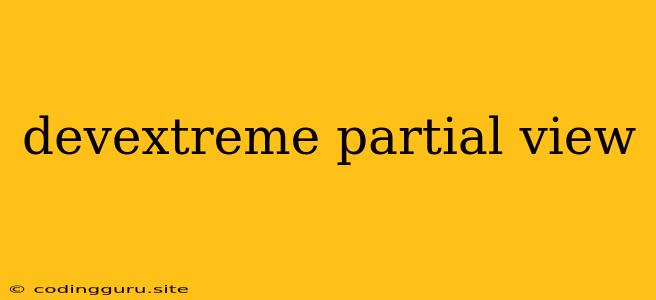Enhancing Your ASP.NET MVC Applications with DevExpress Partial Views
Creating dynamic and interactive web applications requires a blend of efficiency and user experience. This is where DevExpress's powerful component suite and the flexibility of ASP.NET MVC's partial views come together to create a truly synergistic development approach. But how can you best leverage these tools to streamline your development process and elevate your web applications? Let's delve into the world of DevExpress partial views to discover the secrets of seamless integration and impactful results.
What are Partial Views in ASP.NET MVC?
Partial views are a fundamental concept in ASP.NET MVC. They represent reusable snippets of Razor markup that can be embedded within larger views. Imagine them as building blocks, each capable of rendering a specific piece of content, which you can then combine to create the final view. This modular approach brings numerous advantages:
- Code Reusability: Avoid repetitive code by encapsulating common UI elements into partial views. This makes your codebase cleaner, more maintainable, and easier to update.
- Improved Readability: Break down complex views into manageable chunks, enhancing code readability and simplifying the development process.
- Enhanced Flexibility: Modify individual partial views without impacting the entire application. This allows for quick updates and adjustments without disrupting other components.
Why Choose DevExpress with Partial Views?
DevExpress, renowned for its comprehensive UI components and intuitive development tools, offers a seamless integration with ASP.NET MVC's partial views. This synergy allows you to:
- Utilize Pre-Built Components: Leverage DevExpress's extensive library of user interface components like grids, charts, editors, and more within your partial views. These components are feature-rich, visually appealing, and highly customizable, streamlining your development process.
- Effortless Integration: Seamlessly integrate DevExpress controls into your partial views, leveraging their built-in functionalities and enhancing your application's visual appeal and interactivity.
- Maintain Consistency: Ensure a unified look and feel across your application by using the same DevExpress components in different partial views. This ensures a consistent user experience.
Implementing DevExpress Partial Views: A Practical Approach
-
Create the Partial View: In your ASP.NET MVC project, create a new partial view file with the .cshtml extension. This file will contain the Razor markup for the UI element you wish to render.
-
Integrate DevExpress Components: Within your partial view, incorporate DevExpress components using the
@Html.DevExpress()helper method. You can customize the components' properties to match your specific requirements. -
Render the Partial View: In your main view, utilize the
Html.Partial()orHtml.RenderPartial()methods to dynamically render the DevExpress partial view.
Example: Implementing a DevExpress Grid in a Partial View
// Partial View (MyGrid.cshtml)
@model IEnumerable
@Html.DevExpress().GridView(settings => {
settings.Name = "MyGrid";
settings.CallbackRouteValues = new { Controller = "Home", Action = "MyGridCallback" };
settings.KeyFieldName = "Id";
settings.Columns.Add(c => c.DataField = "Name");
settings.Columns.Add(c => c.DataField = "Age");
settings.DataSource = Model;
}).GetHtml()
// Main View (Index.cshtml)
@{
// Pass data to the partial view
var myData = GetMyData();
}
@Html.Partial("MyGrid", myData)
In this example, the MyGrid.cshtml partial view utilizes a DevExpress GridView component to display data. The main view Index.cshtml renders this partial view using Html.Partial(), passing the required data to the grid.
Advantages of Using DevExpress Partial Views
- Efficiency: Reduce development time by leveraging pre-built DevExpress components and the modularity of partial views.
- Scalability: Easily maintain and extend your application by managing individual partial views.
- User Experience: Enhance your application's UI with visually appealing and feature-rich DevExpress components.
- Flexibility: Adapt your application to evolving requirements by updating individual partial views without impacting the whole structure.
Conclusion
By embracing the powerful combination of DevExpress components and ASP.NET MVC's partial views, you can build efficient, visually appealing, and maintainable web applications. This synergistic approach streamlines your development process, improves code readability, and enhances the overall user experience. Start exploring the world of DevExpress partial views today and elevate your ASP.NET MVC development to new heights.
